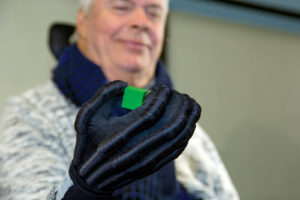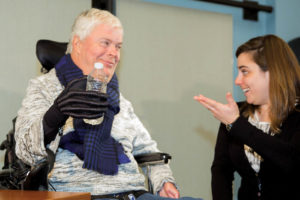A Harvard collaboration develops soft, wearable robotics for hands.

Soft, wearable robotics is an emerging field that looks at methods of enabling functional, powered support to assist human movements using lightweight, low-profile and flexible materials such as textiles. A diverse team of researchers in the Harvard Biodesign Lab at the Wyss Institute for Biologically Inspired Engineering is exploring the use of inflatable, soft, wearable robotics to provide grip strength using a textile-based robotic glove for people with hand weakness.
Addressing hand weakness
Millions of people across the United States are affected by hand weakness, an impairment that limits a person’s ability to perform many common activities of daily living such as eating, drinking and writing. Hand weakness can be the result of many conditions, including stroke, ALS and spinal cord injury. Because these individuals have a perpetual need for support with day-to-day activities, our researchers are developing a device that uses the materials and design of everyday clothing and leverages the functional properties inherent in textiles. The device is composed of a knit base glove with individually sewn chambers that, when inflated, assist the fingers in bending and extending. Much like in a regular glove, textiles in this device provide the optimal combination of function and comfort while also providing much-needed assistance.
How it works

The motions of the glove are made possible by the textile-based knit chambers, or “actuators,” made from three layers of textiles seamed together into a double-chambered sleeve. When a bladder or balloon is placed inside the textile sleeve and air pressure is applied, the balloon inflates and displaces the knit materials, causing them to either extend or bend. To create the extension, two knit textiles with the same mechanical properties are layered and seamed together—in this case a stiff, polyester warp-knit tricot that produces very low elongation when strained. When inflated at 25 psi, the textile chamber stiffens enough to pull the fingers into extension.
To create the motion of flexion, which supports the bending of the fingers, an additional layer of textile is added to the top of the extension chamber. The top layer of the actuator uses a high-stretch nylon/spandex, warp-knit raschel that is selectively modified with segments of a stiff thermoset film. By design and graded sizing, the segments of stiffened material fall in between the finger joints, while the plain raschel knit falls over the joints of the finger. When inflated to 25 psi, the raschel knit will stretch much more than the tricot knit below, causing the actuator to bend while the film-reinforced segments remain straight.
The segments of unbonded raschel articulate over the joints matching the kinematic motion of the fingers. To increase the bending motion, or force applied at each joint, the raschel knit is gathered before it is seamed into the layered sleeve. Additionally, to take full advantage of each textile’s mechanical properties, the sleeves are seamed together with a Merrow ActiveSeam® flat overlock stitch, which also eliminates the bulkiness of a traditional seam allowance. Individual actuators are made to support each finger and are sewn to a knit base glove.
Design considerations are made for the fit, comfort and usability of the glove based on participant feedback during clinical testing sessions. The glove is light (weighing only 1.5 ounces), low profile and unobtrusive when not inflated so that it can integrate into daily life. It has been made in four graded sizes to provide optimal fit and function among users.
Communication, collaboration
This method of creating wearable assistive devices using textiles can be translated to other opportunities—for example, supporting the motion of different joints. When air is put into an actuator, the mechanical properties of the textile will dictate the output. Modifying characteristics, such as textile stiffness and structure, or changing construction assembly and orientation, will yield different motions, such as twisting and contracting, or enable the combination of several motions.
Collaboration is critical in the development of this device. Our multidisciplinary team brings together many fields, including occupational therapy, human biomechanics, functional apparel design, engineering and industrial design. This team is as diverse as our needs, spanning from an understanding of the anatomy of the hand and limitations due to injury or disease, the characteristics of the textiles, engineering of the air supply, sensing and control of the device, and the usability, fit and sizing of the glove.
Communicating across all disciplines can be challenging, and our ability to quickly source materials and fabricate prototypes to review together as a team aids in creating a productive dialogue around device development. This prototyping occurs in different stages of the project with key members of the team. For instance, the development of the actuators might require a test rig that can quantify their performance, bringing together functional apparel designers, engineers and industrial designers.
Once several components come together as a wearable prototype, a review with additional members of the team to include perspectives such as medical needs, human factors and usability are necessary. The physical prototype becomes the common ground for learning about a device—what it’s made from, how it works and where it needs to be improved, serving as a tool for communication and understanding. These considerations culminate in extensive testing of the device on a selected population to validate its function and improve its performance to provide optimal assistance.
Opportunities offered
The field of wearable robotics is growing rapidly, and the use of textiles and functional apparel holds great promise in establishing a platform to develop functional assistive devices that fit and feel just like regular clothing. As we continue to work in this space, we seek opportunities for innovative fiber and textile development and look to emerging manufacturing processes to expand the possibilities of soft wearable robotics, and we would welcome collaborations with materials and manufacturing experts.
In addition to the development of these systems, we are also focused on understanding the best avenues for translating these technologies from a lab setting to industry, where this work can enable accessible solutions and have a positive impact on people’s lives.
Diana Wagner is the senior functional apparel designer at the Wyss Institute. Dr. Conor Walsh is the John L. Loeb associate professor of engineering and applied sciences at the Harvard John A. Paulson School of Engineering and Applied Sciences, founder of the Biodesign Lab, and a core faculty member at the Wyss Institute. This research has been supported by the National Science Foundation and the Wyss Institute for Biologically Inspired Engineering.
 TEXTILES.ORG
TEXTILES.ORG


